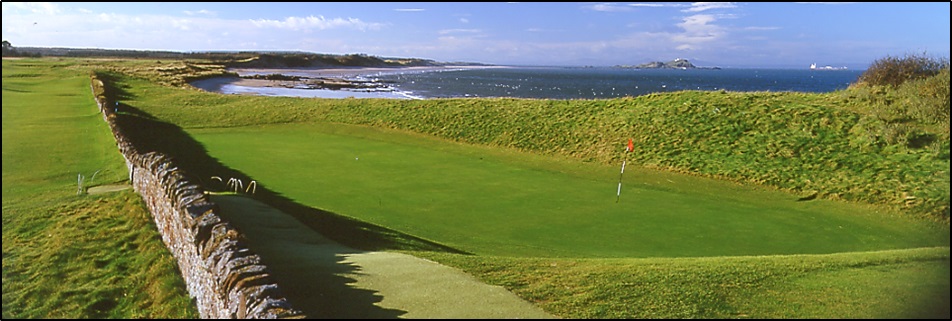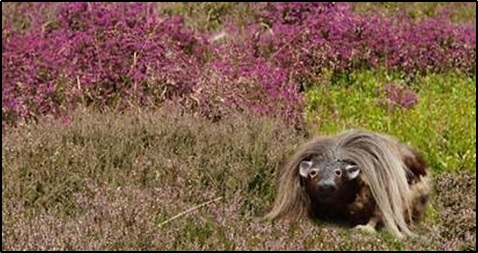the Perils on Scotland’s golf links
The Scottish links course marshals numerous natural defenders on its ramparts, as well as few man-made creations. Faraway Fairways thought we’d compile an appraisal of Scotland’s Hazard County and the perils of links golf that you’ll encounter, ranking them in terms of their evilness.
Wind – Hazard County rating 10
In truth you might feel a bit short-changed were you to encounter benign conditions? Somehow it just wouldn’t be very Scottish. Who really wants to play a becalmed course on the Fife coast after all? Well perhaps in the autumn you can fall in love with the solitude, beauty, and the tapestry of colour that’s unfurling before you. Yes, autumn we’ll grant an honorary exception for, but otherwise you need a little bit of the blowy stuff to keep you honest.
Scotland sits on a relatively northerly latitude. The prevailing wind in the UK is a westerly off the Atlantic, but the most severe tempest is the one that comes in from the North Sea. Carnoustie is particularly savage when the wind decides to take a hand in proceedings, as can be the Lothian coast. It’s early days, but we suspect the giant sands dunes at the Trump International are going to provide some interesting wind shift challenges as you drive from a sheltered tee box only to see your ball dancing wildly as it breaks cover and soars into the exposed yonder.
One of the early shots that the pioneers invented of course was the ‘bump and run’. As the wise old pro would say, “keep the ball under the wind”. It’s why the elevated green as epitomised at somewhere like Royal Dornoch becomes the ying to the wind’s yang. Neither functions without the other. The target of course sits on a plinth, and so the traditional bump and run becomes so much harder to execute with a severe upslope to factor into your calculation. Chuck in a few bunkers to catch the person attempting it, and the risk tariff rises further. The answer to this challenge is to throw the ball up a bit and ride the breeze, like a surfer does a wave. Get it right and you feel an immense sense of satisfaction. Get it wrong and….. oh well… you won’t be the first
Gorse – Hazard County 9
The Scottish word for this yellow flowering plant is ‘whins’. It flourishes on some courses. Notably Royal Dornoch, Castle Stuart, and Royal Troon, but it’s pretty well a perennial headache for any golfer attempting to negotiate safe passage round a links course. We’ve long suspected that this shrub is a dastardly collusion between golf course and golf ball manufacturer. Even if you do succeed in locating the errant shot, more often than not you’ll wish you hadn’t, as the recovery is normally borderline unplayable

The Rivet Bunker – Hazard County rating 9
This is a real Scottish invention, and should be put in the same bracket as the Fair Isle sweater for the suffering and torment its caused. The Old Course at St Andrews has 112 bunkers in total but unlike the giant American bunkers that offer you a chance of a clean shot more often than not, the Scottish variant is designed to penalise. They’re smaller in size, but their heinous depravity is depth, combined with a steep face. The rivet bunker is built up by layered sods of earth and as such presents a vertical wall. They’re probably more akin to giant potholes. Come to rest against the riveted face and there really is little prospect of an escape. Playing laterally is often your only way out.
The most notorious can be found at St Andrews. The Road Hole bunker, the 17th, was where Tommy Nakajima’s Open challenge ended in 1978 when he took four attempts to liberate himself for a quintuple bogey. Naturally, this led the British newspapers to christen that bunker, “the Sands of Nakajima”. In 2005 Costantino Rocca perished in the snare during a play off with John Daly. During regular play Daly had pulled off a remarkable forward escape shot when he found this small but devilish sink hole. This proved crucial. A few hours later it was Rocca’s turn. He needed three attempts, and with this failure the American claimed the claret jug. The most formidable however is the rather unimaginatively named Hells Bunker, at the 14th
The Burn – Hazard County rating 8
We’ve written about why we like burns previously, [Click for article on burns] but just to recap, it’s because they have personalities and character that lakes, or even worse, ‘water hazards’ can never match. They’re also natural and therefore conform with the traditions of the landscape and game colliding in a perfect symphony.
A burn is basically a stream, and proves that you don’t need a large mass of water to present a hazard. The burns of a Scottish links course flow into the sea, which usually means they intercept the course at ninety degrees and form a fairway barrier that devours the bouncing ball with glee. The snaking variety are probably the most feared as these monsters reach out of the fairway to snap at you from all sorts of angles and distances. A lake lacks subtlety. You can see it, and evaluate it, and then make a decision. A burn is a little bit more concealed, even if you know it’s out there. It’s relatively modest width invites you, nah, it teases and taunts you, to take-it-on, as even a bouncing ball can still skip it and land safely. Get it wrong though, and you’re dropping shots.
The Swlican Burn at St Andrews might be the most famous (or photographed), but the most notorious is the Barry Burn at Carnoustie. It was here in 1999 that Jean van de Velde snatched defeat from the jaws of victory at the 72nd hole as he was introduced to the perils of this water serpent.
Long rough – Hazard County rating 6
This wouldn’t be uniquely Scottish, and there is an element of discretionary growth at play here, but it still rates a formidable opponent if you have the misfortune to get tangled up in it. The grass is normally pretty hardy and not easily parted by an aggressive carve
The undulating fairway – Hazard County rating 5
Think of an up turned egg box, crossed with a pin ball machine. In truth the undulating fairway isn’t actually the score wrecker that popular myth would have you believe. Its bigger contribution is possibly psychological, as victims of an unlucky bounce are frequently seduced into bemoaning their luck which can quickly consume them in a maelstrom of negative paranoia. The bigger danger posed by the fickle fairway bounce is probably from the stance it presents the following shot rather than any perceived sense of lost yardage. You’re just as likely to be the beneficiary of a forward bounce and an extra 50yds.
The railway line – Hazard County rating 4
Again we’ve written about why railway lines border so many Scottish courses, particularly so in Ayrshire. Naturally it’s an out-of-bounds, but few players actually bring them into play. Perhaps there’s something overwhelmingly formidable about a train that deters us on this one.
The dry stone wall – Hazard County 3
Although of anthropogenic origin the dry stone wall has a sort authenticity that almost makes it semi natural given the age of some of these things. They were incorporated into designs as courses evolved around what they encountered in the landscape.
The most famous is the 17th , St Andrews, and largely because it offers you one of the classic shots in golf. Coming to rest close against the wall cuts off your backswing and leaves you little shot. The enterprising quickly realised that the best way to gain the green was to cannon a ricochet into the wall and bounce the ball across the road and onto the putting surface. This isn’t a fantasy shot as such, in so far as its been done enough times to make it a conventional response. It’s also true that a few sneaky spare balls have occasionally been accidentally dropped to allow the player to attempt it.
We only ranked this hazard a 3 because of its rarity but anyone who has perished at North Berwick would almost certainly want us to accord it greater recognition. This old-fashioned links (and that’s a badge of honour in this case) has two holes where a wall comes into play. On the third it presents a barrier that runs across the fairway on a drive of about 275 yds. The 13th, ‘the Pitt’, is even more enterprising as the wall runs parallel to the fairway and ultimately in front of the green requiring you to clear it in order to gain the putting surface.

Bagpipes – Hazard County rating 2
This creation is an alleged musical instrument that makes an ear splitting shrill reminiscent of a banshee. OK, it’s tempting to be rude about this particular contribution to melody making that the Scots have visited on civilisation, (because it’s easy) but under certain conditions lamenting bagpipes can actually be hauntingly atmospheric. To encounter them on a golf course though would be unlucky, and invoking them as an excuse for a poor shot not a particularly convincing explanation
The lesser spotted fairway dwelling wild haggis – Hazard County rating 1
Since the explosion in social media, a number of new species of haggis have seemingly come to light. This particular one is a mischievous individual prone to scuttling across fairways and lifting up a golf ball which the player swears blind was an otherwise perfect shot. We do however counsel caution about over using this excuse. You might get away with it once, try something like, “some damned haggis nicked my ball” and roar with affectionate laughter so as not to look unappreciative of the local wildlife and traditions, but we advise that this explanation isn’t likely to survive scrutiny for very long if you come to over-rely on it.







